Janet Lawson
AUTISTRY STUDIOS AND THE DIGNITY OF RISK
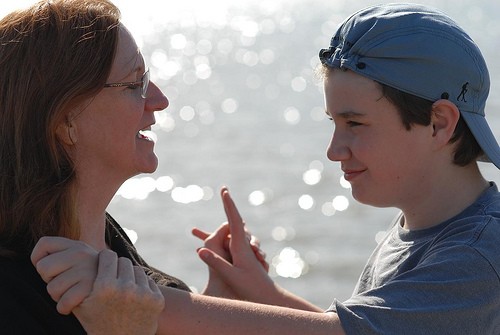
Janet and Ian
As parents of a 16-year-old boy with autism, we have struggled with the desire to keep our son safe and the realization that he needs to be challenged in order to grow. We argue about how far to push him and how tight to hold him. But we realized as we watched him grow that what is true for neuro-typical children is true also for Ian: he learns from his own experience. So, we strive for a balance of protecting him and allowing him to take the risks that encourage self-discovery.
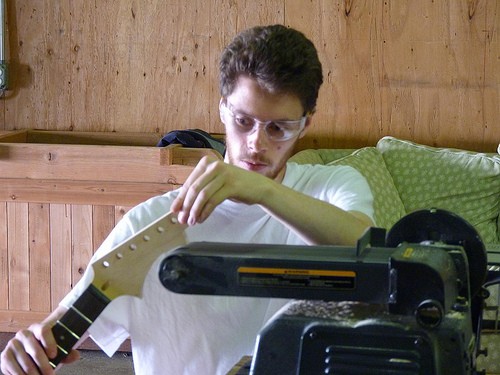
Daniel sanding the guitar
When we began to imagine Ian's life after high school we confronted a huge dark void. There were few programs available for young adults with autism or Asperger's (ASD) once they left the safety of the school system. And those that did exist were focused on recreation and comfort – maintaining the status quo.
So, three years ago we decided to create our own program, Autistry Studios. Our approach reflects what we have learned as parents: the importance of balance between safety and challenge, the need to build on one's strengths, and the dignity of risk.
Creating this program was a challenge for us. Individuals with ASD often have interests that are narrow and fixed and we knew that trying to get them to do something outside of their specific interest probably wouldn't work. So, at Autistry Studios, we take each student's special interest and run with it! We designed our workshops to develop vocational skills while working on projects based on these interests.
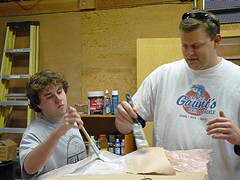
Ian and Jeremy
working on a diarama
Our workshop format is founded upon the following core values:
- Pairing of autism specialist/therapist and master craftsperson
- Small groups: 4 – 5 members
- Long sessions: each group meets for 4 hours
- Weekly meetings and 4 month project duration
- Social Time: a substantial break for a nutritious meal as a group
- individual projects: each participant creates his/her own project
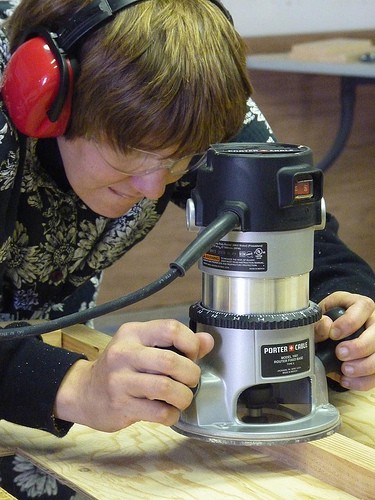
Julia using the router
In the context of engaging in these projects – making a guitar, building a custom designed doghouse, filming an original story - each student's challenges are revealed. One girl came to the program quite skilled at building chairs out of cardboard. We asked her if she would like to build in wood. She hesitated, and then agreed to try. She worked hard to overcome her nervousness around power tools. We worked hard to give her the space to try.
The balance of safety and challenge was never so clear as when Julia used the router for the first time. The look of accomplishment on her face not only gave her a new confidence it gave us a new view of her. To allow a person to take a chance is to show them that you believe in them. This is the dignity of risk.
The dignity of risk is about gradually giving the risk to the individual as a signal of their growing independence. For Julia and the chop saw it works like this. First, we are there closely monitoring Julia as she uses the saw. If there is a mishap, it is our fault. Next, Julia uses the saw on her own but we are watching from afar. We are now splitting the fault (somewhat). The reality is that any mishap is our fault but we are demonstrating trust in Julia, an increase in dignity. We can see our way to someday when Julia uses the saw on her own and no one is "watching." Any fault is now hers but dignity is complete.
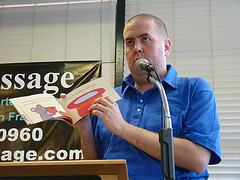
Owen at Book Passage
This week Owen, a young man with autism, had a book signing at Book Passage, a California book store known for hosting events for bestselling authors. He was introduced by the event coordinator. He came to the podium. He paused. He read from his book, Ketinga the Cat. He then asked if there were any questions. Autistry staff and students sat in the audience and watched as all alone on the stage, Owen answered questions. Owen took the risk of speaking in public. He overcame his fears and he forever changed how those in the audience understand autism.

Panda by Abe
We have had several students arrive at Autistry having spent years in recreational art programs. We encourage them to take their passions seriously and develop their skills to the highest degree possible. We invite professional artists to the studio to work with our students.
In 2010, Joan Davis (www.joandavisart.com/) a nationally renowned painter taught a workshop at Autistry Studios. The paintings created that day were exhibited and sold at the San Francisco Palace of Fine Arts.

Bunny with Red Bow
by Breton
This year illustrator and portrait artist Robert Evans (www.evansgallery.net) joined us for a workshop and the resulting works were exhibited and sold at the Marin Art and Garden Center.
By taking seriously the interests and talents of the Autistry students we are able to help them take their skills out of the arena of recreation and into the world of work. By giving them the chance to fail we offer them the opportunity to succeed.